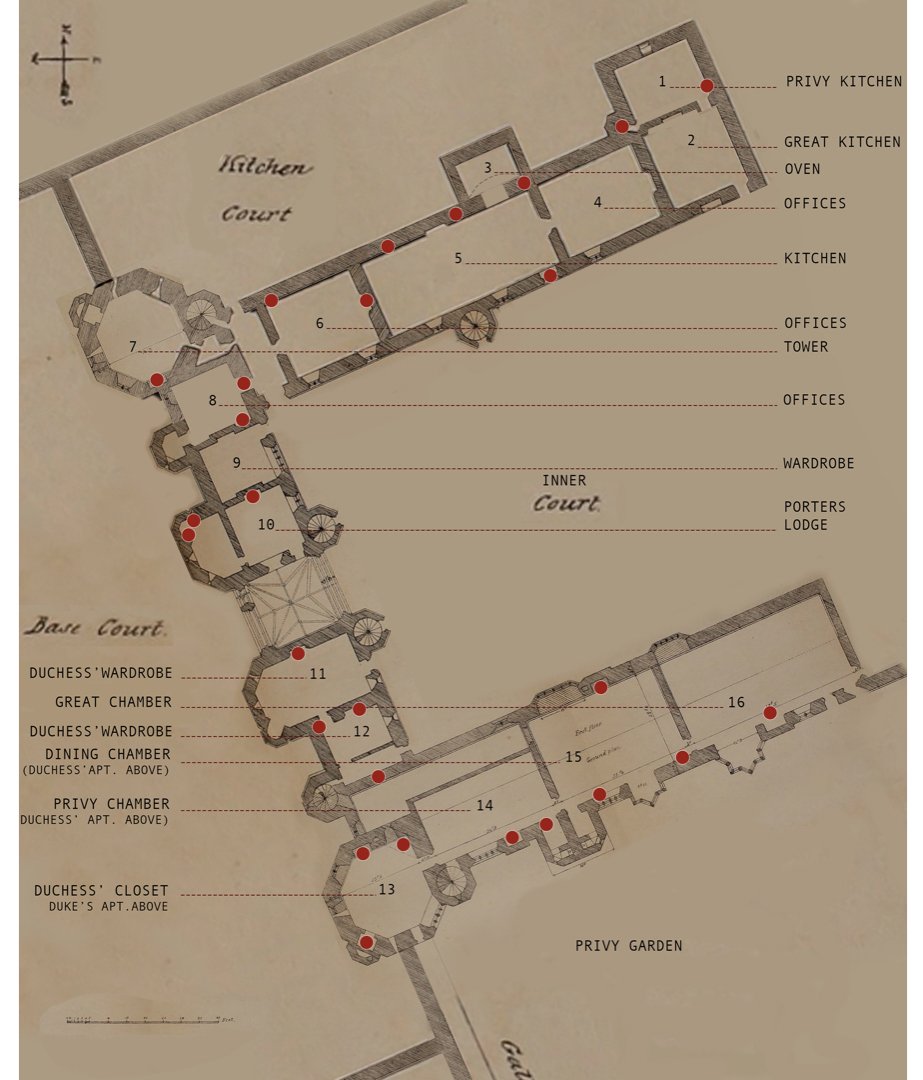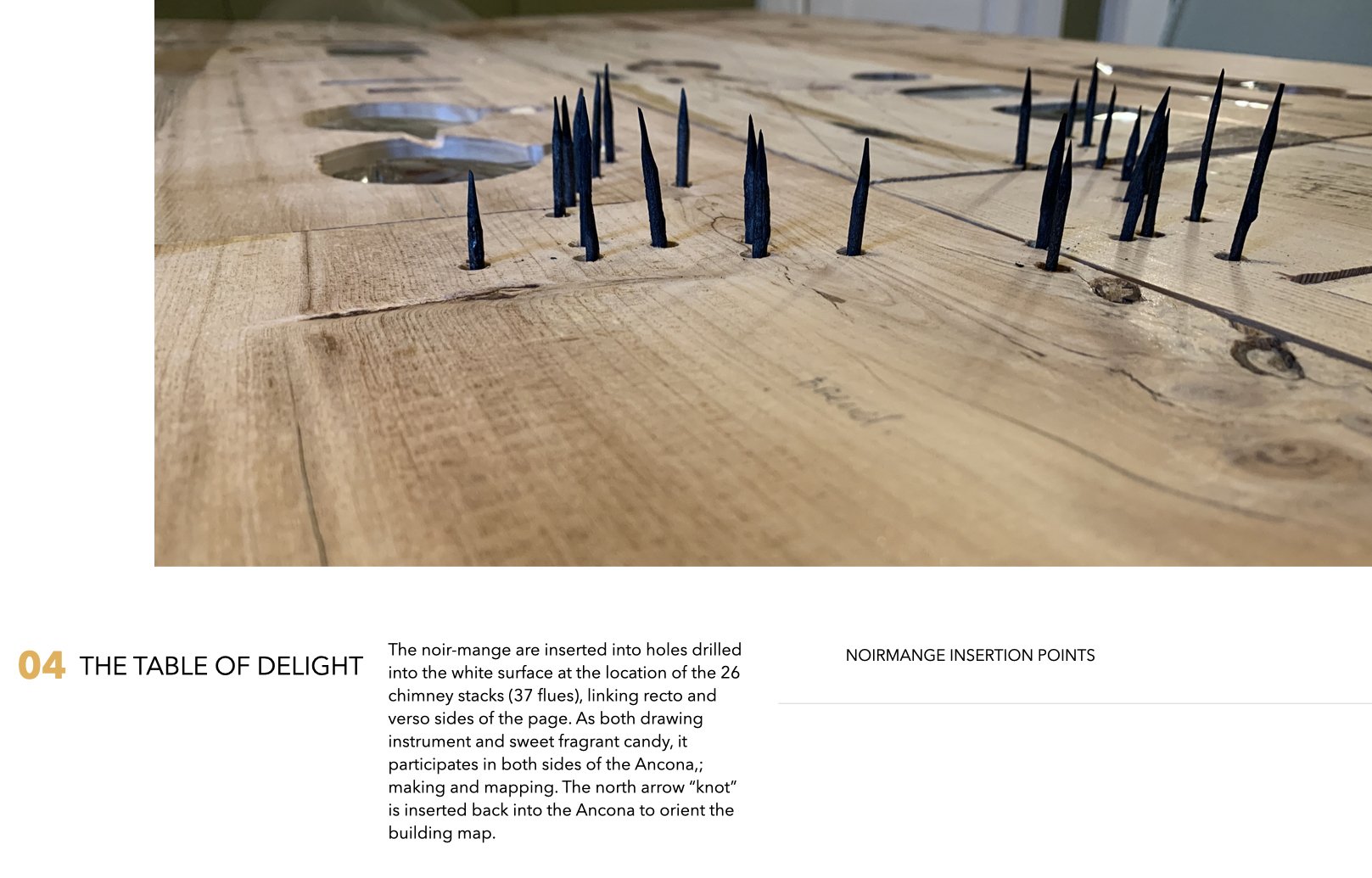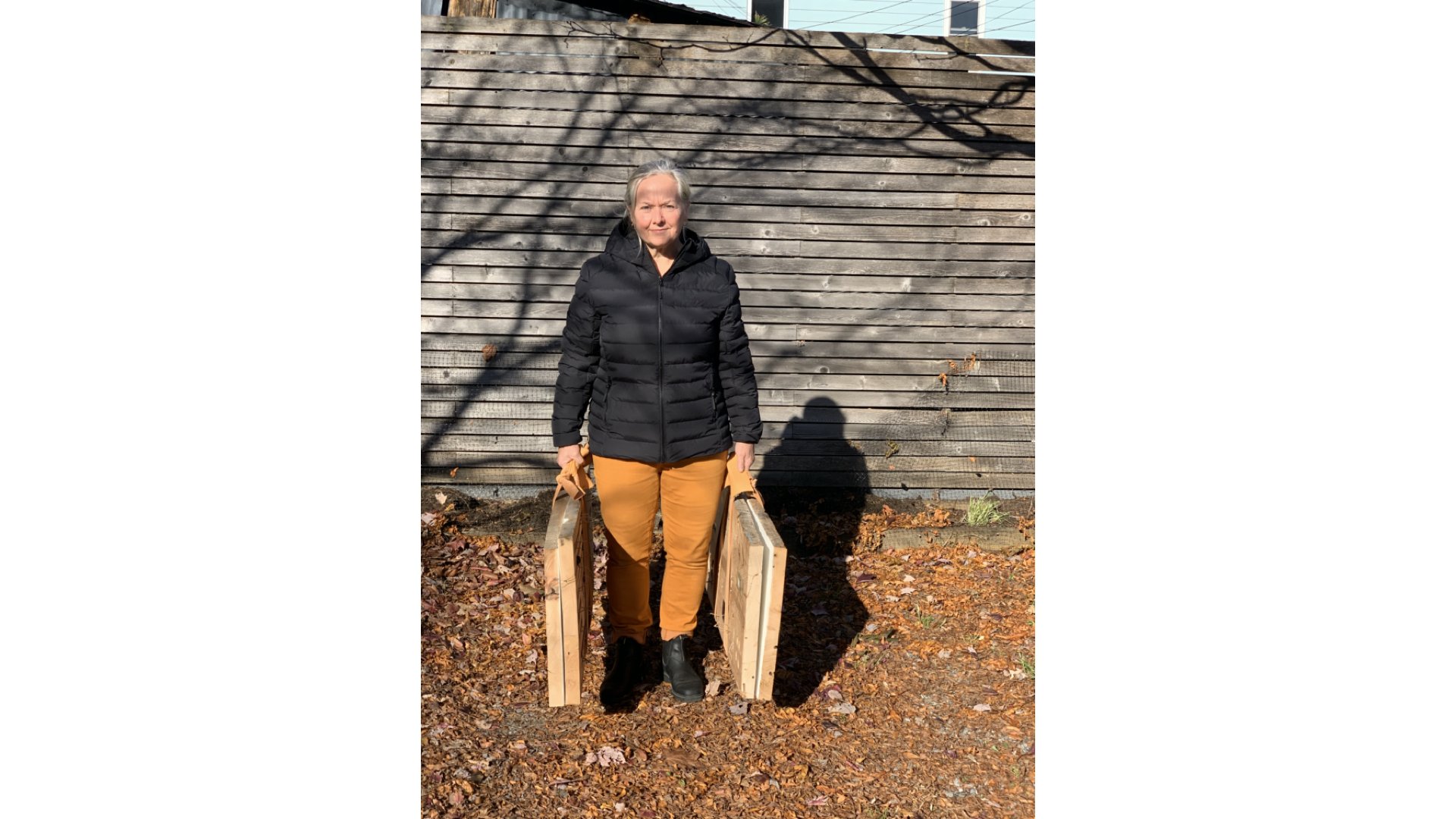CHAPTER 6
Traces and Research Creation: Fragrant Walls and the Table of Delight—On the (Re)Making of Walls, Window, Chimney and Table
PLATE 2.20: "Ceiling" as the thin space of the architect. Part of the Elements of Architecture exhibit by Office for Metropolitan Architecture. The dropped ceiling juxtaposed against the 1909 painted dome by Galileo Chini. Directed by Rem Koolhaus, Venice, Italy, 2013-14. Image courtesy of Guardian News & Media Ltd, Original photo caption: “Through the roof … the 'ceiling' room in the central pavilion – part of Rem Koolhaas's Fundamentals at the Venice Architecture Biennale. Photo: David Levene for the Guardian.”
PLATE 2.21: My mortar and pestle. 8” diameter, Thai granite.
PLATE 2.22: Living fragrant walls at Thornbury Castle: The sweetly scented white climbing Hydrangea Anomala framing the 1514 brick chimney at dawn on the south wall of the inner courtyard (left), roses on the Pleasure Garden wall facing east illuminated at sunrise (right).
Plate 2.23: The “Fragrant Wall Collection.” Twenty-four fragrant wall panels. 1 foot x 1 foot x ½”. Lime plaster with fragrant pigments on drywall.
Plate 2.24: Preparation of the wall panels. Top row left to right: mixing lime plaster slaked in 2008, adding water to rehydrate, it becomes a smooth buttery mixture after mixing; feeling the putty to assess readiness. Middle row left to right: cutting 1 foot x 1 foot x ½ inch drywall panels; applying the casein primer, gold-colored liquid protein (summer 2016). Bottom row left to right: the Kreidzeit casein used, mix test and setting in preparation for first coat of fragrant plaster.
PLATE 2.25: Collecting pigments in the Ottawa Valley
PLATE 2.26: Cooking dyes and testing colours.
PLATE 2.27: “Martino green panel.” One of 24 panels, each 1foot x 1foot x ½” thick. Sage, parsley, thyme, basil, lime plaster, ½” drywall. Using the recipe of Maestro Martino of Como in his Liber de arte coquinaria (recipe for Green Sauce, 77) for edible green pigment from dried garden herbs collected over the summer, working them in the mortar and pestle, then mixing them with lime plaster, the mixture was applied with traditional Venetian plastering tools in three thin layers which created a surface with visual, tactile and fragrant depth.
PLATE 2.28: Dürer’s Nose exhibition including the fragrant wall panels (right rear wall) along with the lime plaster pigments and plaster samples (center table), tools and materials (placed on “fragrance tables” and in niche at the far left and far right). Lightroom Gallery, Carleton University, 20 February – 7 March 2017. Work originally exhibited in EV3.760, Concordia University, 9 August 2017. All work and exhibition installation by author.
PLATE 2.29: Oriel window at Thornbury Castle. Drawing by A. Pugin in Examples of Gothic Architecture, Vol. II. (Edinburgh, 1895), Plate II. Public Domain.
Figure 6.1: Bee boles in niches along east wall of the pleasure garden at Thornbury Castle, 5 June 2018. Photo by author.
PLATE 2.30: Pounding, distilling and assaying. Confectionary window pigments: a) green herbs from my garden, b) steeping saffron, c) casting saffron candy, d) using the copper alembic to distill mint, e) experimenting with temperature for candy, f) casting various pigment panes, g) successful edible glass from moulds, and h) expanding colour range.
PLATE 2.31: “Flavour map” for the confectionary window. The window-glass works like a stained-glass panel, defined by the enfolding of taste and color.
PLATE 2.32: Mixing pigment paints and creating formwork for casting candy window
PLATE 2.33: Confectionary window detail. 24” x 16” x ¼” candy-glass window tinted with herbs, flowers and other fragrant and spicy pigments. Work originally exhibited in EV3.760, Concordia University, 9 August 2017
PLATE 2.34: Confectionary window. An antidote for the sterility of contemporary window experiences. Honey, herbs, spices cast in a wooden frame. 16” x 24”
PLATE 2.35: View of the cap and flue of the 1514 brick chimneys at Thornbury atop the lodgings. Drone flight image by Ben Hayward (pilot) and Sheryl Boyle (conductor), 2017.
PLATE 2.36: Plan of Thornbury Castle showing chimneys. These openings, which are joints between the earth and the sky (the site of architecture), are where the Noirmange sticks are inserted in the table. Drawing by author composed by fragments taken from The History of Thornbury Castle by Richard Ellis (Thornbury: Hamilton Adams and Richard Ellis, 1839).
PLATE 2.37: The Grotesque Chimney. Steps for creating black charcoal drawing sticks by whittling willow twigs; separating the seed scales from the Cedar of Lebanon pinecones from Thornbury Castle and placing them both in tin Bianconeri boxes in a hot fire overnight, covered by black ash and red coals.
PLATE 2.38: Noirmange centers: charred willow twigs used for drawing, made by the author following Cennini Cennini’s recipe. 2” long.
PLATE 2.39: Well-cooked willow drawing sticks. The Bianconeri candy tin has lost its painted label, the pure black “pencils” emerge and draw on the gesso panel beautifully, bringing it to life, and their lines can be erased by bread.
PLATE 2.40: Collecting ingredients for noirmange. Scraping pine resin from areas of the trees which have been scarred or broken naturally near Luskvile Falls (two left-hand images taken by Jane McDonald), wild rose petals collected along Wolf Trail (top three images), various soteltie recipes tried before this recipe settled on (middle right), and black ashes from a Thornbury Castle Cedar of Lebanon pinecone burned in a fire-pit along the Ottawa River (bottom right).
PLATE 2.41: Cooking the black clay: Pine pitch collected into popsicles for storage (right), and then melted in a jar over boiling water with the four other ingredients to create a malleable black clay.
PLATE 2.42: Return to earth: Local wild-rose petals were collected and fermented for one lunar cycle to make a dark rose tea. The five ingredients of blancmange are 1) charred pine cones from Thornbury, 2) pine pitch glue made in the traditional way from locally collected pine pitch, ashes and beeswax, 4) oak gall ink and 5) the rosewater tea.
PLATE 2.43: Material Triptych for lime mortar: Blancmange : Noirmange. Using the same analogical relationship as revealed in Chapter 2, I create a third structure to work in concert with the first two using blackness as my contribution.
PLATE 2.44: Noirmange drawing sticks. As an instrument for drawing, these sotelties expand the visual dimension of drawing to heighten the lower senses including taste, touch and smell.
PLATE 2.45: Bone gesso applied to test board, following Cennino Cennini’s recipe (Chapter 5: The way to start to draw on tablets and the method). The board served as a test for the gesso mixtures, and for drawing with noirmange. My fingerprints are embedded into the surface as gesso is applied.
PLATE 2.46: Harvesting planks from my house in Ottawa. I salvaged the white pine used for the coal chute to my basement for the wood components of the table, leaving the hand-hewn edge of the carpenter before me; I reforged the nails which I removed into a hook to join the ancone.
PLATE 2.47: Building the three-legged trestles: I followed 15th century models, in particular the one in the Onze Lieve Vrouwe ter Potterie, Bruges, Belgium; cut the mortise and tenon joints, dry-fitted the parts and assessed the level.
PLATE 2.48: Details and final assembly. I used the outline of a child’s top in the apex of the legs to encourage those who sit at the table to create ephemeral and playful lines on the white tabletop.
PLATE 2.49: Reconstructing a medieval framesaw to build the trestles. Having used a bucksaw at Peter Minter’s workshop (see Plate 1, Image d) I decided to make one using the guidelines from the St. Thomas Guild. The simple tension system created by twisting a peg through the top band pivots across the center to tighten the blade into place, and it can be disassembled into a slim bundle of sticks for easy transport.
PLATE 2.50: Completed trestles built by the author following measurements of the medieval trestles posted online by the St.Thomas Guild at https://thomasguild.blogspot.com/2012/07/a-15th-century-trestle-table-from-bruges.html of the 15th century trestle-table, part of the permanent exhibit at Onze Lieve Vrouwe ter Potterie, Bruges, Belgium. My reconstruction of these trestles is constructed from reclaimed lumber, with hand-made mortise and tenon joints and dowels following the design in Bruges. Upon completion it became apparent that they nested perfectly together.
PLATE 2.51: Building the ancone. The wood panels are fitted together using hand-planes and spaces are drilled out for the two sets of heavy brass hinges, creating two “books” of wood.
PLATE 2.52: Preparing rabbit skin glue. Dried rabbit-skin was cooked in a double-boiler and then let rest overnight. The resulting glue, or size, is reheated before use, and painted onto the wooden panels, bonding with the next layer.
Plate 2.53: Applying the first coat of size to the pine ancone.
PLATE 2.54a: Coat 1 of bone gesso on ancone.
PLATE 2.55: The wood grain disappears as the gesso is applied, and creates a surface resembling the look and texture of linen. From left to right, details from Coat 2, 3 and 4.
PLATE 2.56: Table of Delight (recto): One coat of size and six layers of gesso on the top surface to make a good surface for drawing. The right image shows the ancone folded to reveal the rough underside.
PLATE 2.57: North Arrow for the drawing created by sanding and polishing a knot which had fallen out along the edge of the panel, gilding it and gluing it back in place with sweet pine pitch glue.
PLATE 2.58: Using pins at the edge of the table, I stretch red string across the surface to delineate areas in the building plan where I will apply fragrances. The strings do not touch or mark the white surface, and are removed once the process is complete. The chimneys are located and holes drilled through the table for the Noirmange to be inserted, joining both sides of the table.
PLATE 2.59: Fragrance Map legend. Zones of fragrance on the recto surface of the table. The lines shown on this image are used only to communicate the areas where I have rubbed fragrances into the table. The actual “drawing” is not perceived by the eyes, but rather by the sense of smell and touch when seated at the table. The black Noirmange fills the chimney pots with fragrant, sweet, tactile ink.
PLATE 2.60: Fragrance Map ingredients. Materials set in areas defined by threads delineate the zones of fragrance at Thornbury Castle. Threads are attached to brass nails at the edges of the ancone, making reference to the action used by scribes who used this technique to rule lines on parchment and also used by masons who placed batter-boards beyond the corners of buildings in order to “draw” the lines of the building onto the site.
PLATE 2.61: Noirmange as key: Inserted through ancone like chimneys, the Noirmange bridges from recto to verso and joins the space of the workshop (verso) to the space of the Fragrance Map (recto) creating a projected field of sensory delight from which an architecture can emerge.
PLATE 2.62B (also Figure 6.2): Table of Delight filled (verso). A sensory toolbox for the artisan. Divided by sensations and qualities experienced in these exercises. Top right (fragrance), bottom right (sweetness), bottom left (luminosity), top left (colour). Objects are recessed allowing the panels to be separated into two halves, then folded into two “suitcases” for transport to the next project. The white fragrant recto side is protected on the inside of the suitcase.
PLATE 2.63: The Table of Delight folded. The two ancone are folded and tied, holding all the tools and substances for a journey to the next project.
PLATE 2.64: Pin, string and silverpoint stylus used to inscribe the gesso with a circle, twice.
PLATE 2.65: Drawing blancmange with silverpoint, preparing the Table of Delight for installation at the defence.
PLATE 2.66: Sensory toolkits for the defence committee. Due to Covid-19, in order for the Defence Committee to experience the Fragrance Drawing, boxes of the ingredients used to create the drawing were mailed to the committee along with a section of the gesso test panel and a Noirmange soteltie to draw with.
PLATE 2.67: The Defence Exhibition: The table was set with the fragrance kits before they were mailed out. Fragrant Wall (left), Confectionary Window (top right), Noirmange sotelties (center) and Table of Delight, recto side fragrant drawing prepared for others to draw upon it with the sweet Noirmange sticks at center.

















































